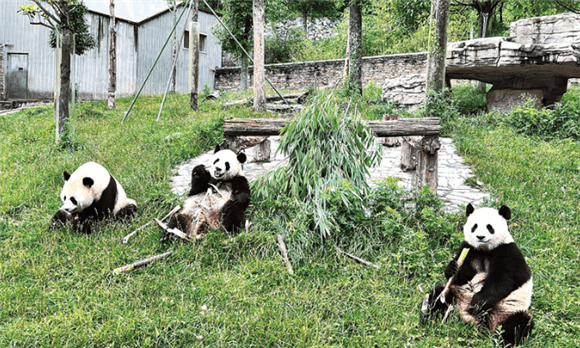With its black and white fur, round body shape, and naive movements, the giant panda, this ancient relic species from 8 million years ago, makes people look forward to it and fall in love with it.
The giant panda is also known as the "iron-eating beast". Guo Pu, a writer of the Jin Dynasty, mentioned in his annotation of "The Classic of Mountains and Seas·Laishan" that "the panda appears in Qionglai Mountain, which looks like a bear but is black and white, and also eats copper. iron". In 1869, French naturalist and priest Armand David sent giant panda specimens to the French National Museum of Natural History for display. This unique species in China instantly caused a worldwide sensation.

From the 1990 Beijing Asian Games mascot "Panpan" to the 2008 Beijing Olympics with the panda From the prototype mascot "Fuwa Jingjing" to the mascot "Rongbao" of the Universiade to be held in Chengdu in July this year, the giant panda has become a symbol of peace and unity around the world.
Giant panda protection "prescribes the right medicine"
Throughout history, giant pandas have traveled all over the Yellow River, Yangtze River, and Pearl River basins. Currently, their wild habitats are only in the three provinces of Sichuan, Shaanxi, and Gansu.
Giant pandas were once on the verge of extinction. One of the reasons was the lack of suitable habitat and the fragmentation of ecological corridors. Giant pandas belong to the family Ursidae. Adult giant pandas have a head and body length of 1.2 to 1.8 meters, a weight of 80 to 120 kilograms, and a maximum weight of 180 kilograms. Their huge body means that adult giant pandas have almost no natural enemies, but they also need to maintain a considerable amount of food. .
"Giant pandas are omnivores. If they only eat bamboo, each adult giant panda needs to eat 30-40 kilograms a day. Eating takes them a lot of time. Apart from eating, they usually rest because their claws Ji Jian is good at climbing trees and often rests in trees to hide," said Wei Rongping, director of the Wolong Shenshuping Base of the China Giant Panda Conservation and Research Center.
With frequent human activities, wild giant pandas currently inhabit high mountains and deep valleys at an altitude of about 2,600-3,500 meters in the upper reaches of the Yangtze River - Minshan, Qionglai Mountain, Liangshan, Daxiangling, Xiaoxiangling, and Qinling 6 strips of land. The temperature in these places is below 20 degrees Celsius all year round, the environment is humid, bamboo grows well, and food and water sources are abundant.
Difficulty in estrus, difficulty in mating and conception, and difficulty in raising young to survive are also important reasons for the limited number of giant panda populations. "Giant pandas go into estrus every spring, and their eggs have a short survival time. If you don't seize the chance of conception, you have to wait another year. And giant panda pregnancy has the characteristics of delayed implantation of fertilized eggs and dormant free movement, and the gestation period is between 60 and 300 days. No, monitoring is more difficult," Wei Rongping said.
Despite the difficulties, my country's efforts to protect giant pandas have never stopped, and a combination of in-situ and ex-situ protection is working hard.
Since the establishment of the first batch of giant panda nature reserves such as Wolong and Rangshuihe in 1963, my country has successively established 67 giant panda nature reserves, effectively protecting 53.8% of giant panda habitats and 66.8% of giant panda habitats. % of the wild giant panda population. According to the Fourth National Giant Panda Survey, as of the end of 2013, there were 1,864 wild giant pandas in my country, including 1,387 in Sichuan Province, 345 in Shaanxi Province, and 132 in Gansu Province. Compared with the 1,596 in the third survey, the number of wild giant pandas has increased steadily.
In the 1960s, my country began to explore artificial breeding of captive giant pandas. In the 1980s, the China Giant Panda Conservation and Research Center and the Chengdu Giant Panda Breeding Research Base were successively established to specialize in giant panda breeding and protection research. After more than 40 years of hard work, from rescuing seriously ill pandas to introducing behavioral research on giant pandas, and then exchanging experience in international wildlife breeding and rescue, the average life span of captive giant pandas in my country has increased by about 10 years, and the population has steadily expanded. As of the end of 2022, the captive population of giant pandas will reach 698.
In 2016, the IUCN Red List of Endangered Species was updated, and the protection level of the giant panda was downgraded from "endangered" to "vulnerable". This is yet another recognition by the international community for the protection of China’s flagship species. "Currently, wild giant pandas are divided into 33 local populations, 18 of which have less than 10 populations, and some even have only 1-2 giant pandas. The possibility of population extinction is very high and requires attention." Compared with the "optimism" of the international community, Wang Yanfei, deputy director of the Ya'an Management Branch of the Giant Panda National Park, remains sufficiently clear-headed.
With the official establishment of the Giant Panda National Park, the protection of giant pandas in China has been further upgraded. "The Giant Panda National Park connects 82 protected areas involving giant pandas and includes all potential habitats of giant pandas, solving the problem of habitat fragmentation and achieving the greatest protection of giant pandas," Wang Yanfei said. .
Maintain 90% genetic diversity for 200 years
The giant panda population needs to be large enough and stable, and the genetic diversity must be rich enough to increase the adaptability and survivability of the population. , providing a richer foundation for reproduction.
In 2012, the national giant panda optimized breeding and matching program was launched to implement eugenics and eugenics for the captive population. Statistics predict that the captive giant panda population can maintain 90% of its genetic diversity for up to 200 years, and has basically formed a healthy, dynamic, and sustainable population.

In contrast to this ability, there is the possible population extinction and genetic loss of small isolated populations in the wild. Lost permanently. This requires introduction into the wild and reintroduction into the wild to achieve two-way rejuvenation.
China Giant Panda Conservation and Research Center Wolong Hetaoping Base is responsible for the wild introduction and wild training and release of giant pandas in my country. "Currently, a more scientific and mature model has been explored for the reintroduction of giant pandas into the wild in my country, which is a two-stage wild training of mother animals and cubs. In the first stage, expectant female giant pandas are placed in a semi-wild area to give birth, raise their cubs, and raise them. In the process of taking care of their daily diet and health, the staff try to avoid appearing in front of the cubs; in the second stage, the female giant panda leads the cubs into a larger and more natural wild environment to teach the cubs various types of survival. ability. This kind of cubs born and living in a semi-wild and wild environment are more adaptable to the wild environment," said Wu Daifu, director of the Wolong Hetaoping Base of the China Giant Panda Conservation and Research Center.
Currently, my country has released a total of 11 giant pandas, 9 of which survived, which has effectively promoted the rejuvenation of small wild populations. In addition, they successfully gave birth to 5 litters of 8 cubs through wild introduction, with 7 surviving cubs. This enabled the captive population to be replenished without destroying the wild population.
The Giant Panda National Park has planned and constructed more rewilding training areas, which will be more conducive to future rewilding and reintroduction work. In the future, the Hetaoping Base will accelerate the innovation and promotion of key technologies such as giant panda training, reintroduction, and monitoring, increase the protection of endangered small populations of wild giant pandas through introduction, and gradually establish a wild giant panda genetic germplasm resource bank. , realizing two-way genetic exchange between captive and wild populations.
More than 1 billion people around the world have watched giant pandas
Although giant pandas come from China, the love for giant pandas knows no borders or races, and the protection of giant pandas has attracted worldwide attention.
As of June 2023, our country has established scientific research cooperation relationships with 22 zoos in 19 countries. The total number of giant pandas carrying out international cooperation overseas has reached 64, and a total of 65 giant pandas have been bred alive since the cooperation. , has effectively carried out cooperation in scientific research, protection, and education around the world, popularized giant panda knowledge around the world, continuously enhanced the public's awareness and participation in protecting wild animals and the ecological environment, and better promoted the protection of endangered species.
Over the years, the international giant panda partners have given full play to the advantages of collective wisdom, resource superposition and knowledge sharing, and have jointly overcome a series of technical problems in the fields of giant panda protection, breeding, disease prevention and control, and reintroduction into the wild. It not only promotes the improvement of genetic diversity and health level of captive giant pandas, continuously optimizes the population structure, and continuously extends the average life span, but also significantly improves the scientific and technological support capabilities for the protection of giant pandas and their habitats, effectively promoting wild conservation.
More than a thousand people have carried out training on the protection of endangered wild animals such as giant pandas through international cooperation projects, cultivating a large number of professional and technical personnel and business backbones, while promoting the protection of giant pandas and driving the global protection of wild animals and plants. Improvement of overall level.
The total number of tourists visiting giant pandas from all over the world has exceeded 1 billion. Giant pandas have spread the concepts of peace and unity to all parts of the world and have become messengers of friendship between China and people of other countries.
Since the outbreak of the COVID-19 epidemic, my country has established an online communication platform to promote close exchanges between top international giant panda scientific research institutions represented by the China Giant Panda Conservation and Research Center and foreign cooperation units. "Cloud guidance" is provided on the daily life, feeding and management, disease research, etc. of overseas giant pandas. In 2021, giant pandas living in Malaysia, Japan, France, Singapore, Spain and other countries gave birth to 8 cubs, which was the largest number of overseas cubs since the launch of international cooperative research.
Our country has successively established the Sichuan Provincial Key Laboratory of Conservation Biology of Endangered Wild Animals - the National Key Laboratory Cultivation Base jointly built by the province and the ministry, and the National Forestry and Grassland Administration Key Laboratory of Conservation Biology of Rare Animals in the Giant Panda National Park. laboratory to carry out in-depth scientific research on giant pandas. Global cooperation and exchange platforms have also been established one after another, such as the International Conference on Giant Panda Conservation and Breeding, the Cross-Strait and Hong Kong and Macau Giant Panda Conservation Education Seminar, and the Giant Panda Breeding Technology Annual Conference, to exchange and discuss new methods and technologies for giant panda protection. and new achievements, and actively promote the protection of giant pandas.

 扫一扫微信交流
扫一扫微信交流
发布评论